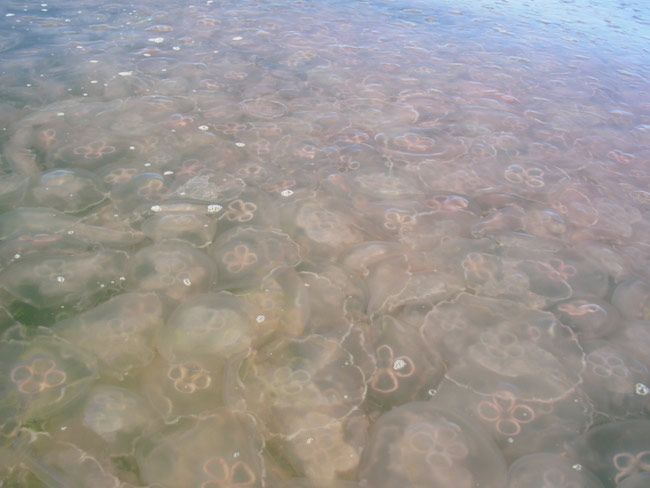Jellyfish Invasions Force Shutdowns at 3 Separate Nuclear Plants

A nuclear power plant on the coast of Israel was forced to shut down this week when its seawater cooling system became clogged with jellyfish. A similar incident temporarily disabled two nuclear reactors at the Torness power station on the Scottish coast last week. A week before, a reactor in Shimane, Japan was crippled by yet another jellyfish infiltration.
Amid speculation that warm waters and ocean acidification — both driven by climate change — are boosting jellyfish populations, are these three incidents signs of a growing trend?
"The several [power plant incidents] that happened recently aren't enough to indicate a global pattern. They certainly could be coincidental," said Monty Graham, a jellyfish biologist and senior marine scientist at the Dauphin Island Sea Lab off the Gulf Coast of Alabama.
Graham said there have been dozens of cases of jellyfish causing partial or complete shutdowns of coastal power plants in the past few decades, as well as shutdowns of desalination plants. Steve Haddock of the Monterrey Bay Aquarium Research Institute said a power plant in Australia was shut down by jellyfish as long ago as 1937. Such events aren't surprising; all these plants draw water out of the ocean, and they are already fitted with filtration devices called flumes that remove jellyfish and other debris.
"Only when you have a huge influx of jellies do they overwhelm the flumes," Graham told Life's Little Mysteries. This happens when a jellyfish bloom — a huge swarm of adult specimens brought together by ocean currents — flows into a power plant's filtration system.
Jellyfish blooming occurs mostly in the spring and summer months, which may partly explain why the three recent power plant incidents happened in close succession. While conditions brought on by climate change may also be creating more jellyfish blooms than there used to be, signifying a worldwide jellyfish population explosion, researchers can't tell whether that's occurring; they began tracking jellyfish populations too recently.
"In some places, there have been some dramatic population increases in the past few decades, but overall, it's hard to identify a trend," Graham said. "We don't have the hard data because we haven't been looking at jellyfish on a long enough timescale."
Sign up for the Live Science daily newsletter now
Get the world’s most fascinating discoveries delivered straight to your inbox.
Claudia Mills, a jellyfish biologist at the University of Washington, said that there are some documented cases of local population increases. For example, an invasive species has been spreading in the Mediterranean for decades, and may be the culprit that clogged the Israeli plant. However, Mills told us, a lot of the concern about rising populations on a larger scale is based on hyperbole. "We don't know what is going on with jellyfish in most parts of the world," she wrote in an email. [Read: Jellyfish Swarms: Menacing or Misunderstood?]
Some researchers do suspect that populations are rising, as jellyfish may thrive in warmer oceans. "Jellyfish populations spike and wane with climate variability, so it's not hard to make the logical leap that if climate is changing long-term, we'll likely see a population change," Graham said. He is conducting research to investigate whether jellyfish populations are increasing globally, and if so, why.
Of course, a higher incidence of power plant-jellyfish standoffs (if, in fact, the incidence is higher) could also reflect the increasing number of coastal power plants, Graham said.
Either way, getting the power plants back online is not such a difficult fix.
"Plants only have to deal with a heavy-duty problem once or twice and they'll realize it's such a huge cost to them that they'll introduce countermeasures," he said. These include additional filters and a jet bubble system that makes incoming jellyfish float to the surface, where they can be skimmed off. "In some cases, the plants can just monitor for jellies and shut down temporarily when there's a bloom."
This article was provided by Life's Little Mysteries, a sister site to LiveScience. Follow us on Twitter @llmysteries, then join us on Facebook. Follow Natalie Wolchover on Twitter @nattyover.
Natalie Wolchover was a staff writer for Live Science from 2010 to 2012 and is currently a senior physics writer and editor for Quanta Magazine. She holds a bachelor's degree in physics from Tufts University and has studied physics at the University of California, Berkeley. Along with the staff of Quanta, Wolchover won the 2022 Pulitzer Prize for explanatory writing for her work on the building of the James Webb Space Telescope. Her work has also appeared in the The Best American Science and Nature Writing and The Best Writing on Mathematics, Nature, The New Yorker and Popular Science. She was the 2016 winner of the Evert Clark/Seth Payne Award, an annual prize for young science journalists, as well as the winner of the 2017 Science Communication Award for the American Institute of Physics.











